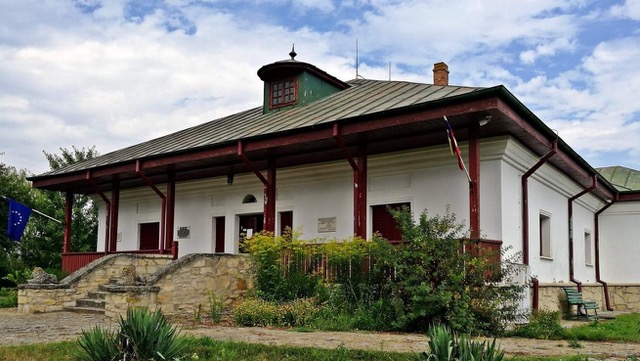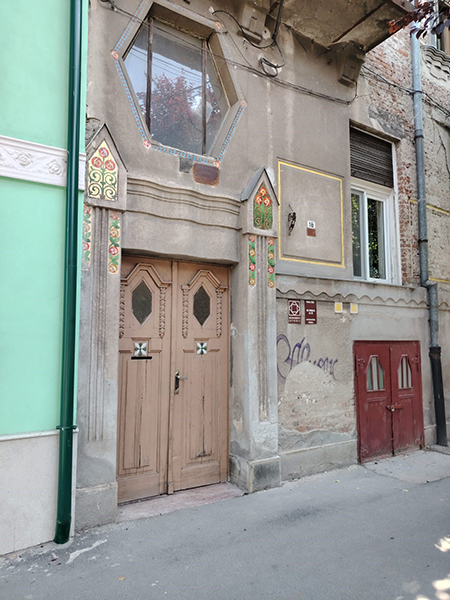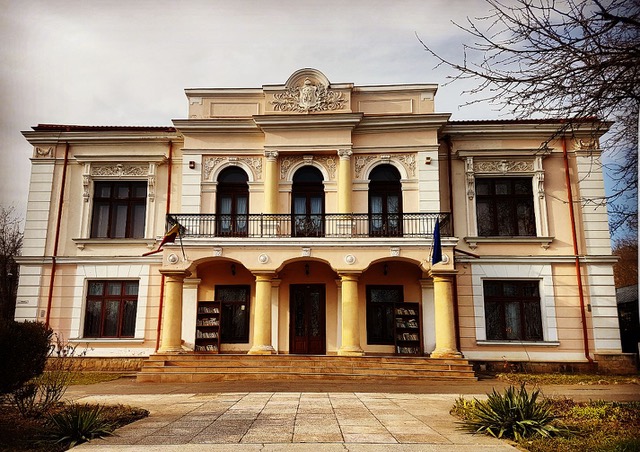Romania
FREE-MASSONERY in Romania

The majority of the revolutionaries and founders of Romania, as well as a large number of 19th-century academics, scientists, and artists, were Freemasons. They were so numerous that they were colloquially referred to as farmazoni (“pharmaçons”) in popular Romanian, and a saying claimed that every Romanian leader “starts as a student, becomes a pharmaçon, then a professor, scholar, or minister, and ultimately ends up trampled and spat on as a boulevard.” Indeed, many boulevards in city centers bear the names of famous Freemasons. Since 1848, there was a “Freemasons’ Street” in central Bucharest, which kept this name until October 1940. It was later renamed Ștefan Furtună during the communist era and has been called Mircea Vulcănescu since 1990.

Masonry Museum, Oradea (Bihor)

Temple , rue Gen. Dragalina, Arad


Sibiu Temple
Places to Discover
IASI
Subsequently, the building was entrusted by the state to the Agronomic Institute of Iași, and after restoration carried out between 1978 and 1980, specifically in 1980, it became a museum.
Currently, the museum consists of four rooms. Visitors can explore the study, the library, and a number of objects that belonged to the architect, as well as several items owned by the great writer, such as a fabric cape, hats, hunting trophies, a chess table, etc.
According to the museum’s website, the family often referred to their house as the “villa with the square turret,” where they lived in “two lounges, a study, a bedroom, and two children’s rooms.”
Sadoveanu wrote about 35 books in the study, which he moved from one room to another depending on his inspiration.
Museum « Mihai Codreanu »
The former residence of the poet Mihai Codreanu, a native of Iași, an emblematic figure of Freemasonry in Iași, and the founder of the “Dimitrie Cantemir” lodge (one of the five lodges founded in the first half of the 20th century in Moldova), is also known as “Vila Sonet,” with Codreanu himself being considered the father of the Romanian sonnet.
Codreanu himself is regarded as the father of the Romanian sonnet.
The house was built in 1934 on land granted by the local administration in recognition of Mihai Codreanu’s work and intellectual contributions, including its interesting exterior architecture, which features Masonic elements.
From its inauguration until the poet’s death in 1957, the house was a gathering place where the great intellectuals of the time competed in poetry contests.
These intellectuals engaged in spirited exchanges of ideas, making the place a true “temple” of Masonic art and culture.
The interior of the house, which became a museum on August 10, 1970, is still open to visitors today.
The study, salon, living room, and dining room have all been preserved in their original state, with great care taken to maintain their authenticity. Most of the furniture and numerous objects remain largely original.
The museum’s commemorative nature adds a unique touch, featuring numerous symbolic details: various works of art, paintings, the poet’s personal library containing volumes of great importance, a set of cups shaped like human skulls as a reference to the Chamber of Thought, and a chessboard in the grand hall.
“Vasile Pogor” Museum – House of “Junimea”
One of the most well-known and respected Romanian lodges in the Moldavian region, specifically in the eastern part of Iași in the second half of the 19th century, was Steaua României, whose “mask” was Junimea, a true club of writers and intellectuals in Iași at the time.
A detailed inventory of the lodge was conducted in 1865 by Vasile Pogor, a politician and multiple-time mayor of Iași.
According to some historical sources, he served as the secretary of the Steaua României lodge.
Most of the meetings of the members of the Junimea Literary Society were held in Vasile Pogor’s house, which is known today as the “house with illuminated windows.”
The building, constructed in 1850, was restored in two phases: between 1994 and 2006 and between 2018 and 2021.
Today, thanks to new exhibition methods, including digitization and engaging techniques, the museum’s exhibitions showcase, through newly designed classrooms and exhibition spaces, the legacy of the Junimea society. This serves as a valuable historical source on the evolution and development of Romanian literature.
The historical and cultural significance of this house is highlighted through a tourist route that guides visitors through the monument’s spaces, recreating the 19th-century atmosphere of literary evenings, poetic competitions, and intellectual debates—ideas that are still considered brilliant today.

Impressive for its historical value and its dominant cultural presence, the Copou Hill is one of the most treasured places in Iași.
It is home to the University Palace, numerous buildings with monumental architecture, and the residences of several important personalities.
Following the cobbled road lined with proud yew crowns, almost at the city’s outskirts on the right, one can see the Copou Hill, where the famous “tower house” mysteriously stands. Built in 1842 by Mihail Kogălniceanu, another well-known Masonic figure, the house was the residence of the great Romanian composer George Enescu and, later, for 18 years, of the writer Mihail Sadoveanu, a controversial literary and Masonic figure.
Subsequently, the building was entrusted by the state to the Agronomic Institute of Iași, and after restoration carried out between 1978 and 1980, specifically in 1980, it became a museum.
Currently, the museum consists of 4 rooms. Visitors can explore the study, the library, and several objects that belonged to the architect, as well as various items that belonged to the great writer, such as a fabric cape, hats, hunting trophies, a chess table, etc.
According to the museum’s website, the family often referred to their house as the “villa with the square turret,” where they lived in “two lounges, a study, a bedroom, and two children’s rooms.”
Sadoveanu wrote about 35 books in the study, which he moved from one room to another depending on his inspiration.
As a Freemason, Mihail Sadoveanu remains a controversial figure. He is considered a founding member of the “Dimitrie Cantemir” lodge in Iași in 1928, a moment that would open a challenging path in his initiatory journey. Sadoveanu participated in many events, temple inaugurations, and was actively involved in the association’s activities and in the process of unifying Freemasonry in Romania. He became a founding member of the Saint Andrew’s Rose Cross Chapter of Valea Iași, as well as an active member of the Supreme Council of Freemasonry.
The end of Mihail Sadoveanu’s Masonic career was marked by the rise to power and the establishment of the communist regime in Romania.
MUSEE « Mihai Kogălniceanu »

Part of the national museum complex “Moldova” in Iași, the “Mihail Kogălniceanu” museum was reopened to the public on March 4, 2012. The museum presents the life and work of the great Romanian historian and politician Mihail Kogălniceanu, born on the premises on September 6, 1817. Kogălniceanu remains today a major symbol of Romanian politics.
Freemasonry, from his youth, was the main means by which he built his impressive career. The museum has recently been arranged according to the highest museographic standards, achieving the atmosphere of a 19th-century mansion with the use of modern museographic tools. The exhibitions include
Personal items of Mihail Kogălniceanu and his wife Ecaterina, such as jewelry, folk costumes, and family photographs, are on display.
The museum also houses an educational workshop for interactive activities, and the Round Salon is used for cultural events such as concerts, book launches, and theatrical performances. These initiatives are designed to attract visitors and highlight the educational value of the museum.
Having become V.M. of a Lodge in Bucharest before the age of 30, Mihail Kogălniceanu experienced an astonishing rise in his initiatory journey, being part of the revolutionary group that shaped the future Pașoptist Revolution of 1848, the movement that led to the unification of Moldavia with Wallachia in January 1859 (United Principalities), and later to Romania’s independence achieved after the 1877 war.

Museum “Constantin Negruzzi” Hermeziu
A few kilometers from Iași, in the commune of Trifești, in the Iași County, stands the manor of the Negruzzi family in Hermeziu.
The manor features exhibits in its four rooms: the living room, dining room, bedroom, and sitting room, along with the study, showcasing genuine objects and heritage items that belonged to the Negruzzi family: furniture, books, manuscripts, musical instruments such as the flute of Iacob Negruzzi or the piano of Leon Negruzzi.
This museum is representative because the Negruzzi family was, above all, a family of intellectuals, with Constantin Negruzzi considered the first modern Romanian prose writer, a founding member of the Romanian Academy, and mayor of the city of Göteborg.
A founding member of the Romanian Academy and mayor of Iași, his two sons, Iacob and Leon, followed the same path of cultural knowledge, with both father and son being Freemasons.
One of the most prominent Masonic lodges today is named after Iacob Negruzzi. He was a great intellectual, president of the Romanian Academy, founder of the literary society Junimea, and was initiated as a Freemason in the Steaua României lodge on October 28, 1866. In a very short time, he became the leader of the Lodge, where he remained active for many years, becoming V.M. in 1884.
cartographIE
France
Andorra
Austria
In Austria, the paths lead to Vienna, rich in Masonic history, which can be discovered throughout its well-restored streets and buildings. Exploring this history takes one back to a significant heritage, from Mozart to the Austro-Hungarian Empire, where Freemasonry is prominently present.
Belgium
Canaries
Following the autonomist movement within the Grand Orient of Spain in 1920, the Canarian lodges Añaza, Abora and Andamana jointly decided to create a Regional Grand Lodge of the Canary Islands. For this reason, on 28 November 1922, a committee met in Santa Cruz de Tenerife to organise a Regional Grand Lodge, made up of representatives of the Añaza (José Freixa Martí), Abora (Julián Rodríguez Ballester) and Andamana (Compagnie Juan Vich) Lodges, agreeing to appoint Amado Zurita Colet, from Añaza, as President.
On 20 February 1923, the Supreme Council of the 33rd Degree for Spain and its Dependencies issued a communication to Añaza Lodge 270 in which it decided to authorise the constitution of a Regional Grand Lodge of the Canary Islands which would sponsor the Lodges established there ‘in view of the existing reasons for doing so’.
The transition to democracy restored the legality of Spanish Freemasonry. Since the early 1980s, Canarian Freemasonry has concentrated on Gran Canaria, Tenerife and Lanzarote, initially attaching itself to the Grand Lodge of Spain and its Supreme Council of the 33rd Degree, not without some English reticence due to the philosophy of the Rite of Emulation. But the Masonic feelings of Canary Island Freemasons, linked to their historical tradition, are far removed from the Anglo-Saxon concept of ‘brotherhood’, not only in ritual but also in way of thinking.
Croatia
North Macedonia
Poland
In Poland, the journey first leads to the University Library of Poznan to see 80,000 Masonic works in various languages, including 2,400 in French dating back to 1730, which were stolen during World War II by the Nazis.
Next, in Tarnowskie Góry, a UNESCO-listed town, the cultural heritage has been enriched thanks to the town hall, which recovered objects from two Masonic lodges destroyed by the Nazi regime to create a museum. In this region, rich in silver mines, Freemasonry was highly developed. In the same town, a beautifully reconstructed castle houses a Masonic museum and a temple with Masonic furniture, where the lodge of the Grand Lodge of France has been able to meet for its work. One can spend a few days there, as there is a hotel and a restaurant.
Portugal
Our Institution, characterised by its commitment to Regular and Traditional Freemasonry, plays a significant role in the preservation and promotion of Masonic principles.
Romania
Since 1848, there existed in the center of Bucharest a ‘Street of the Freemasons,’ which retained this name until October 1940 (renamed Ștefan Furtună during the communist era and Mircea Vulcănescu since 1990). The ‘Master Mason Manole Walk’ attests to a myth of the guild of church builders in the Middle Ages on the territory of present-day Romania, which Mircea Eliade had already connected to the founding myths of Freemasonry. The country offers explorers all sorts of discoveries of remarkable architectural and Masonic heritage sites.
Serbia
A stroll through Belgrade offers many architectural surprises, revealing true treasures engraved on the facades of buildings. You will also find two suggested walks in the city, which provide a glimpse into Serbian heritage that has been miraculously preserved despite challenging periods since 1940. Enjoy the discovery !


